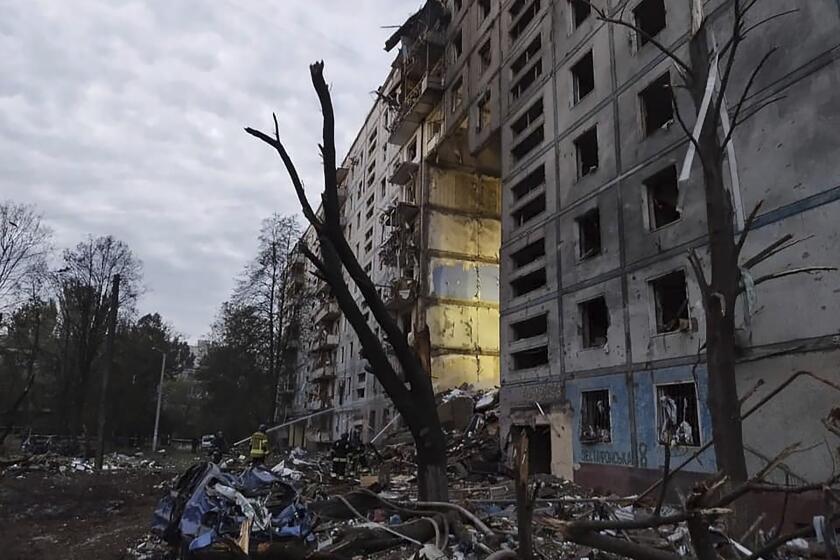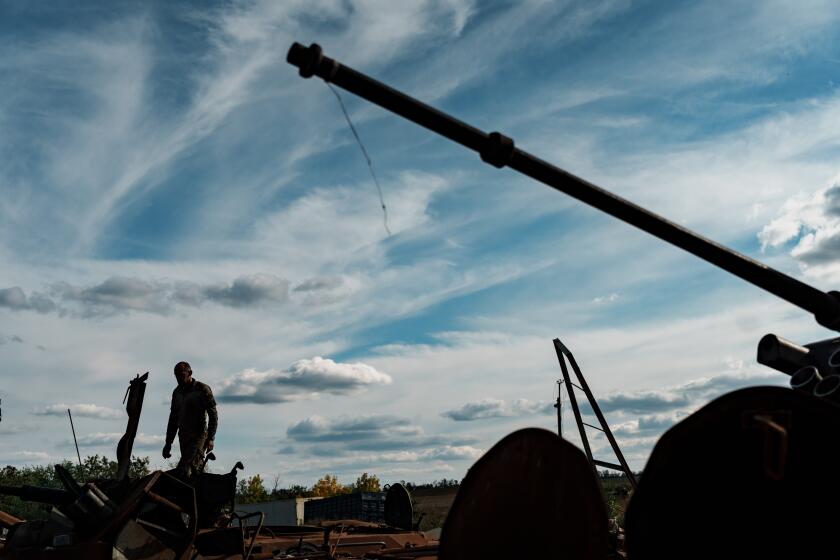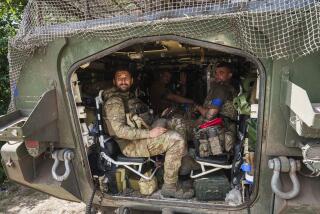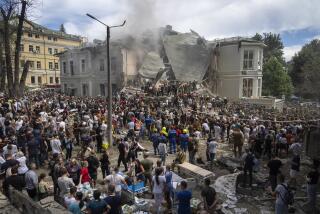Russian missile strike damages energy facility in Kyiv region, Ukraine says
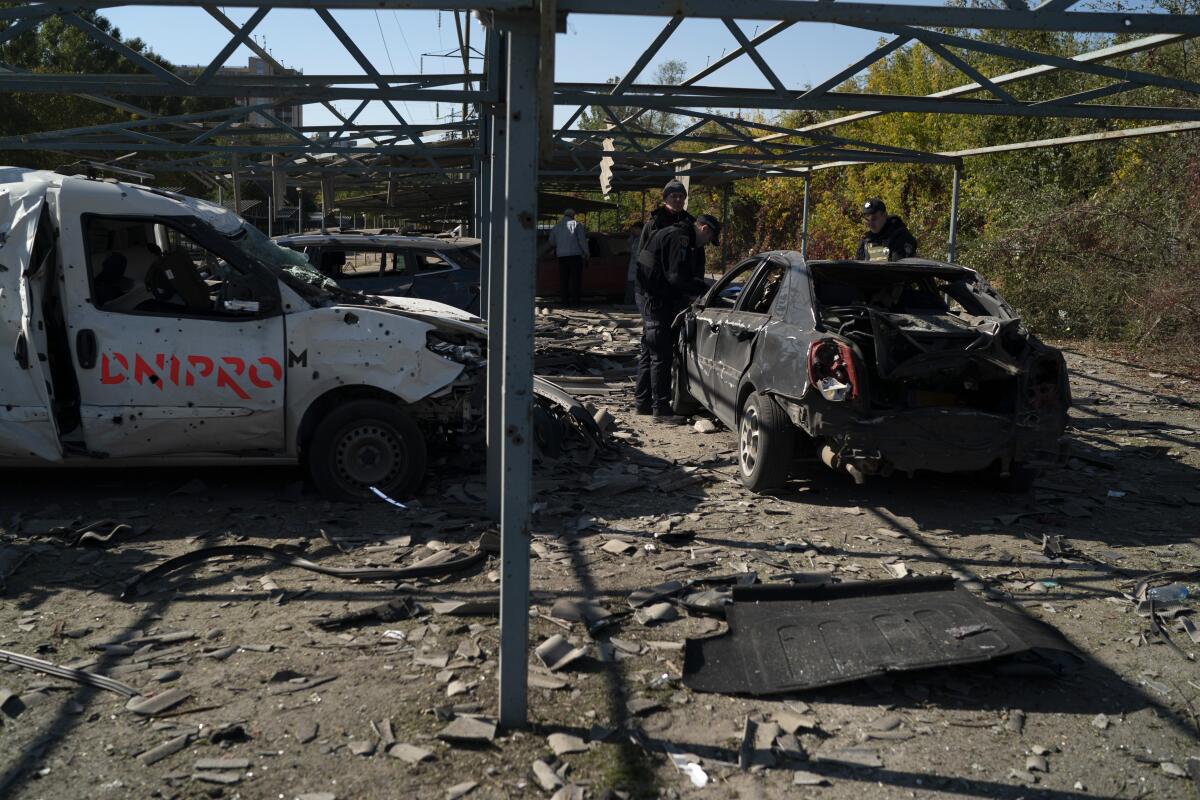
- Share via
KYIV, Ukraine — Regions of southern Ukraine that Russian President Vladimir Putin illegally annexed saw more heavy fighting Saturday as Ukrainian soldiers pressed a ground campaign to recapture one, and Russian forces exploded long-range missiles and Iranian-made drones in another.
A missile strike also seriously damaged a key energy facility in Ukraine’s capital region, the country’s grid operator said. Following mounting setbacks, the Russian military has worked to cut off power and water in far-flung populated areas while also fending off Ukrainian counterattacks in occupied areas.
Dmytro Pocishchuk, a hospital medic in the Zaporizhzhia region’s capital who has treated dozens of people wounded during Russian attacks in recent weeks, said people sought safety outdoors or in his building’s basement when the familiar blasts started at 5:15 a.m. Saturday.
“If Ukraine stops, these bombings and killings will continue. We can’t give up to the Russian Federation,’” Pocishchuk said several hours later. He put a small Ukrainian flag on the broken windshield of his heavily damaged car.
Russia has lost ground in the nearly seven weeks since Ukraine’s armed forces opened their southern counteroffensive. This week, the Kremlin launched what is believed to be its largest coordinated air and missile raids since Russia’s invasion of Ukraine on Feb. 24.
Kyiv region Gov. Oleksiy Kuleba said the missile that hit a power site Saturday morning didn’t kill or wound anyone. Citing security, Ukrainian officials didn’t identify the site, one of many infrastructure targets the Russian military tried to destroy after an Oct. 8 truck bomb explosion damaged the bridge that links Russia to the annexed Crimean Peninsula.
A Russian barrage pounded apartment buildings and other targets in the Ukrainian city of Zaporizhzhia, killing at least 13 people and wounding dozens.
Ukrainian electricity transmission company Ukrenergo said repair crews were working to restore electricity service, but warned residents about further possible outages. Kyrylo Tymoshenko, the deputy head of the Ukrainian president’s office, urged residents of the capital and three neighboring regions to conserve energy.
“Putin may hope that by increasing the misery of the Ukrainian people, President [Volodymyr] Zelensky may be more inclined to negotiate a settlement that allows Russia to retain some stolen territory in the east or Crimea,” said Ian Williams, a fellow at the Center for Strategic and International Studies, a policy organization based in Washington. “A quick look at history shows that the strategic bombing of civilians is an ineffective way to achieve a political aim. ”
This week’s wide-ranging retaliatory attacks, which included the use of self-destructing explosive drones from Iran, killed dozens of people. The strikes hit residential buildings as well as infrastructure such as power stations in Kyiv, Lviv in western Ukraine, and other cities that had seen comparatively few strikes in recent months.
Putin said Friday that Moscow didn’t see a need for additional massive strikes but his military would continue selective ones. He said that of 29 targets the Russian military planned to knock out in this week’s attacks, seven weren’t damaged and would be taken out gradually.
The Institute for the Study of War, a think tank based in Washington, interpreted Putin’s remarks as intended to counter criticism from pro-war Russian bloggers who “largely praised the resumption of strikes against Ukrainian cities, but warned that a short campaign would be ineffective.”
In the Zaporizhzhia region, Gov. Oleksandr Starukh said the Russian military carried out strikes with kamikaze drones from Iran and long-range S-300 missiles. Some experts said the Russian military’s use of the surface-to-air missiles may reflect shortages of dedicated precision weapons for hitting ground targets.
Ukrainian forces have recently recaptured swaths of territory in northeast, east and south, sending Russian troops fleeing. But in ravaged towns, suffering doesn’t stop with occupation’s end.
The neighboring Kherson region, one of the first areas of Ukraine to fall to Russia after the invasion and which Putin also illegally designated as Russian territory last month, remained the focus of a Ukrainian counteroffensive.
Kyiv’s army has reported recapturing 75 villages and towns there in the last month, but said the momentum had slowed, with the fighting settling into the sort of grueling back-and-forth that characterized Russia’s months-long offensive to conquer Ukraine’s eastern Donbas region.
On Saturday, Ukrainian troops attempted to advance south along the banks of the Dnieper River toward the regional capital, also named Kherson, but didn’t gain any ground, according to Kirill Stremousov, a deputy head of the occupied region’s Moscow-installed administration.
“The defense lines worked, and the situation has remained under the full control of the Russian army,” he wrote on his messaging app channel.
The Kremlin-backed local leaders asked civilians Thursday to leave the region to ensure their safety and to give Russian troops more maneuverability. Stremousov reminded them they could evacuate to Crimea and cities in southwestern Russia, where Moscow offered free accommodations to residents who agreed to leave.
Maj. Gen. Igor Konashenkov, the Russian Defense Ministry’s spokesman, said the military destroyed five crossings on the Inhulets River, another route Ukraine’s fighters could take to progress toward the Kherson region.
Rights groups say Moscow’s practice of transporting captured Ukrainian civilians to Russia is illegal under international law. Hundreds, perhaps thousands, have vanished from Russian-occupied areas.
Konashenkov claimed Russian troops also blocked Ukrainian attempts to make inroads in breaching Russian defenses near Lyman, a city in the annexed Donetsk region of eastern Ukraine that the Ukrainians retook two weeks ago in a significant defeat for the Kremlin.
To the north and east of Kherson, Russian shelling killed two civilians in the Dnipropetrovsk region, Gov. Valentyn Resnichenko said. He said the shelling of the city of Nikopol, which is located across the Dnieper from the Russian-occupied Zaporizhzhia Nuclear Power Plant, damaged a dozen residential buildings, several stores and a transportation facility.
Fighting near the nuclear plant, Europe’s largest, has been an ongoing concern during the nearly eight-month war. The power station temporarily lost its last remaining outside electricity source twice in the past week, fueling fears the reactors could eventually overheat and cause a catastrophic radiation leak.
International Atomic Energy Agency Director-General Rafael Grossi reported that such fears were somewhat eased late Friday, because Ukrainian engineers had managed after several weeks to restore backup power lines that can serve as a “buffer” in case of further war-related outages.
“Working in very challenging conditions, operating staff at the Zaporizhzhia Nuclear Power Plant are doing everything they can to bolster its fragile offsite power situation,” Grossi said. “Restoring the backup power connection is a positive step in this regard, even though the overall nuclear safety and security situation remains precarious.”
More to Read
Sign up for Essential California
The most important California stories and recommendations in your inbox every morning.
You may occasionally receive promotional content from the Los Angeles Times.
